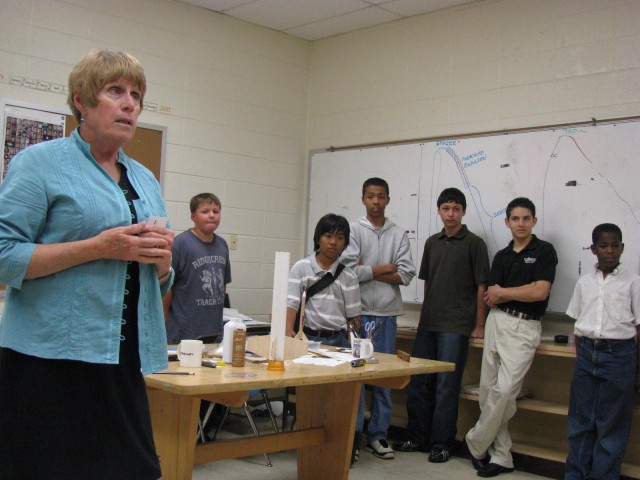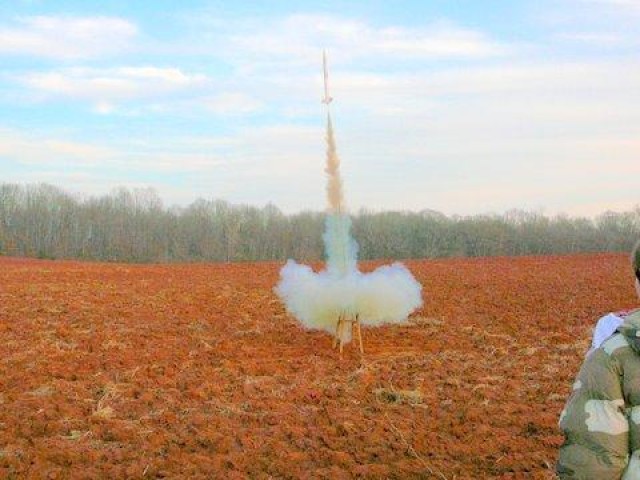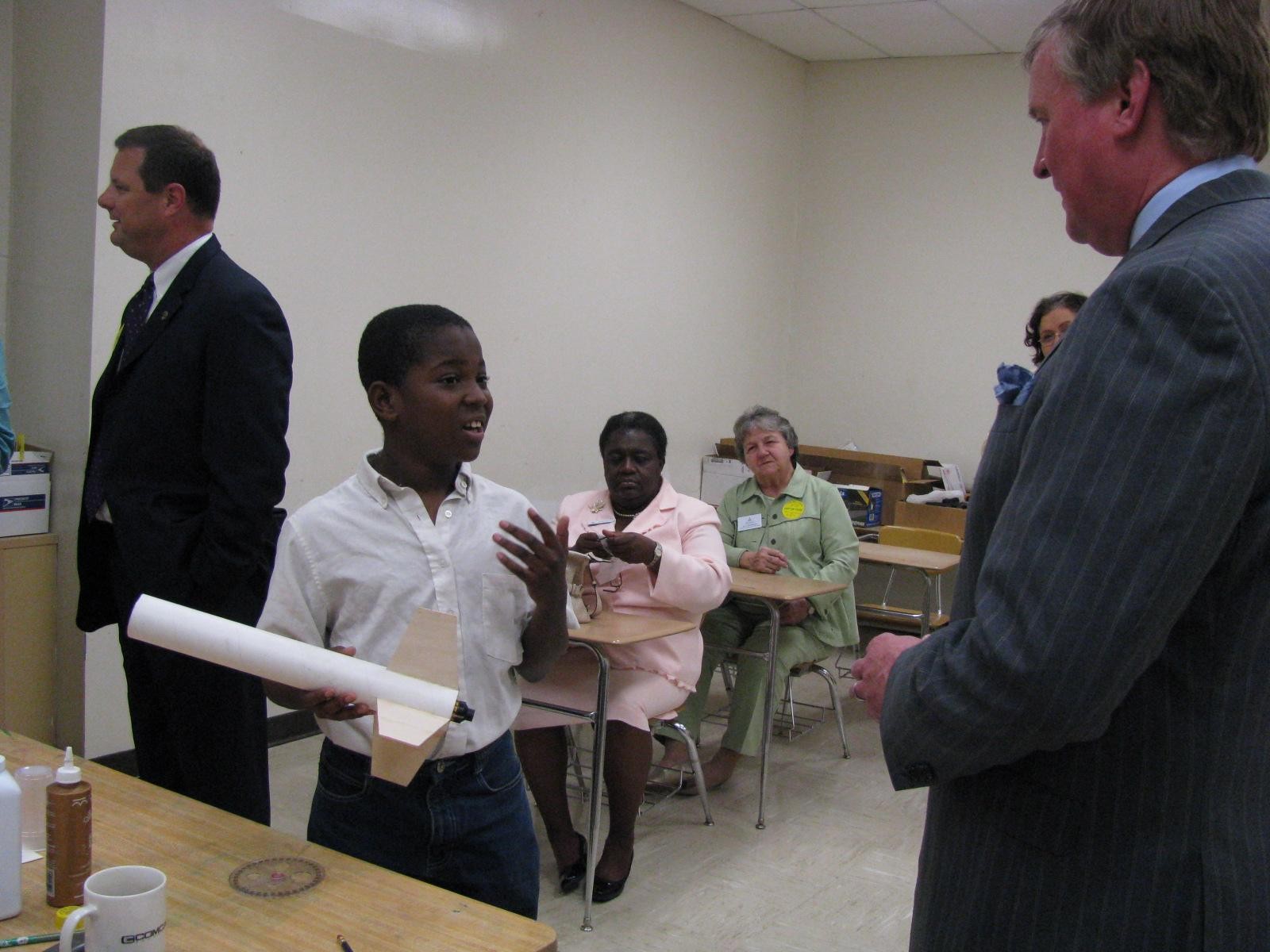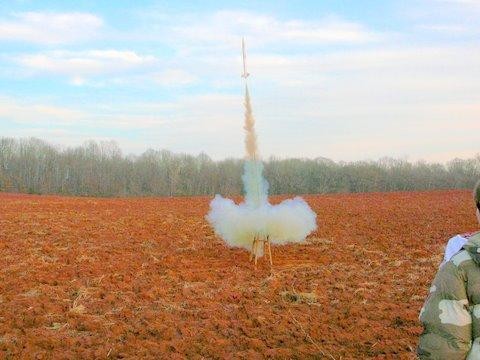As a volunteer, Michael Murphy is having an influence on the future of aerospace.
For the past three years, this engineer has given up many Tuesday afternoons and some Saturday mornings during the school year to help students at Stone Middle School explore the possibilities, limitations and challenges of rocketry.
He has helped teams of students work with computer programs to design rockets, and then select materials to build and fly rockets. He has helped them analyze their flight results and make changes so that future flights are more and more successful.
"When we get a design that we think is close to the goal, we build and then fly it, and see how close we came to our computer model," said Murphy, a fixed wing integration engineer at Redstone Arsenal for the program executive office for Intelligence, Electronic Warfare and Sensors.
"They are using a lot of skills they learn in the classroom and applying them to real world problems. They get to see how their classwork applies to real problem solving."
This year, Murphy helped the Rocket Boys from Stone become the only team from Alabama to make the finals in the nationwide Team America Rocketry Challenge, the largest rocket contest in the world sponsored by the Aerospace Industries Association and the National Association of Rocketry in conjunction with NASA, the Defense Department, the American Association of Physics teachers and 34 AIA member companies. Out of 653 teams registered for the competition, Stone Middle School's six-member team was one of the top 100 teams selected nationwide based on their qualifying score to travel to northern Virginia in May for the National Fly Off.
The Team America Rocketry Challenge for 2009 was to fly a rocket carrying a raw egg to the target altitude of 750 feet with a flight time goal of 45 seconds. The raw-egg payload had to be transported on its side to mimic the position of an astronaut and could not be cracked or broken when it returned from flight. Although the Stone team did not place in the national competition because of parachute failure, the boys learned a lot about competing, and what it takes to excel in science and math fields, Murphy said.
"They now have the realization that they can compete in academic things that involve math and science as well as any kid going to school in this area," he said
"At a Title One school that is very, very important because it shows if they apply themselves and work really hard they can break out from where they are in the social economic strata and they can do well. They can get in a good college and get a good job and then they can start living the American dream. That's the most rewarding thing that I find in working with these kids."
A Title One school is a school that has a high percentage of students from low income families.
"These kids come from an environment where they don't have much of an opportunity to succeed," Murphy said. "To break out of that cycle, they need to have success so they know they can compete with the best of them."
That success came March 31 when the team launched their rocket from a cotton field next to McDonnell Elementary School. They met the challenge by flying their rocket 748 feet with a flight time of 45.45 seconds, coming the closest to the requirements of 750 feet and 45 seconds, and beating out 19 other teams in Alabama to go to the national competition.
Their qualification score was 2.90 on a scale where 0 is perfect, coming in well below the cutoff score of 17.6 that was needed to be invited to the national competition.
The Rocket Boys from Stone included Anthony Nelson, Mark Bond, Victor Rodriguez, Jackson Myrick, Elijah Archie and Moquin Tonbuavone. Throughout the school year, they redesigned their rocket several times until they came to their final design of a 41-inch-long rocket that has a 70-millimeter booster section and a 2.930-inch diameter payload section. The fully loaded rocket, which carried the raw egg and an electronic altimeter to record height, weighed 1.71 pounds at liftoff.
"We had some faults, of course. In real life there are a lot of things that can go wrong," explained Nelson, an eighth-grader on the team. "At one point, our motors kept exploding and we discovered we had gotten a bad batch of motors. But when we qualified we had no faults and almost a perfect score."
Murphy said a lot of analysis was done by the boys during the year. For instance, at one point they got a rocket to fly to 60 feet. They then had to decide how they wanted to increase the fly height, either by reducing the rocket's weight, increasing its boost or both.
"They had to do a lot of computing and base their design on data from all their flights," he said. "They looked forward to the time we spent together. After our meetings, they would ask 'Are we meeting again next Tuesday'' or 'Can we fly this weekend'' It was fun to watch their excitement and enthusiasm. It is rewarding to actually be able to sit down and talk with boys, and actually teach them about rocketry."
Nelson said the experience was about more than seeing how high and how fast a group of boys can fly a rocket.
"I've learned a lot because I had never flown a rocket before this. And I had to learn how to protect an egg while flying the rocket," he said. "Mr. Murphy was our mentor. He taught us how to do it and he helped us along the way."
The Rocket Boys from Stone have received proclamations and congratulatory letters from Gov. Bob Riley, the Alabama Legislature, the Huntsville City Board of Education, Huntsville Mayor Tommy Battle, U.S. Secretary of Education Arne Duncan and Sen. Richard Shelby.
"This program is all about the kids. These kids are going to be the future engineers to take our places when we retire," Murphy said. "The goal of this contest is to bolster student interest in science, technology, engineering and mathematics education in an effort to attract young people to aerospace careers. If we don't do that, who will do this work and who will understand this technology when we all retire'"
This was the second team Murphy took to the national competition. The 2007 team made it to national and the 2008 team barely missed the nationals. Besides helping the students, he also writes grant requests to get funding for the program. This year, funding was received from UAH Inservice Group, Alabama A&M University, Pratt & Whitney, Huntsville Area Technical Society, Rocketdyne and Optimist Club of Southeast Huntsville.
"We have proven that this is money well spent because these kids are going to be the future engineers and scientists that will work in the aerospace industry," Murphy said. "This is just a payment on the future."






Social Sharing